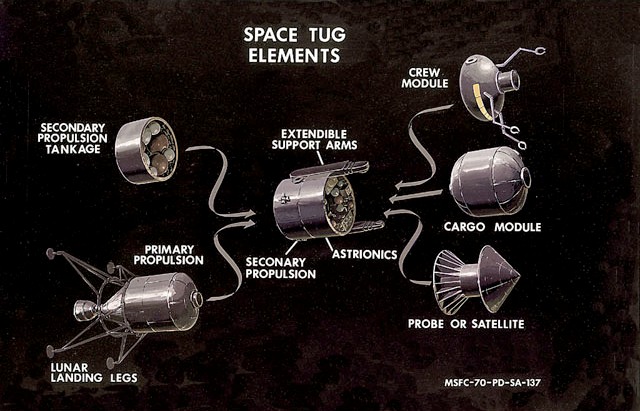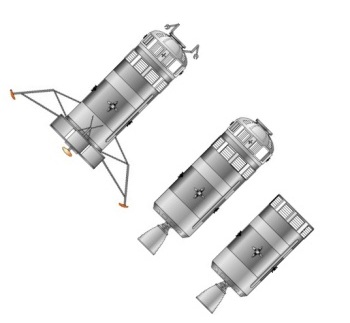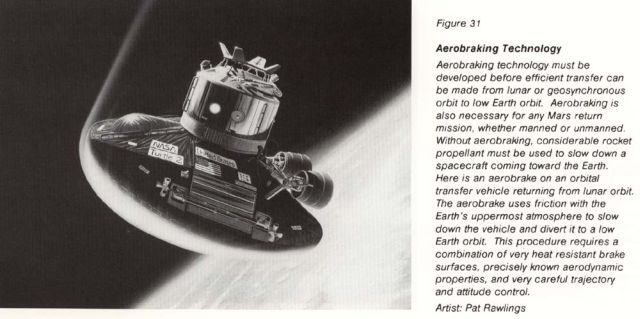

American space tug. Study 1971. The original Boeing Space Tug design of the early 1970's was sized to be flown either in a single shuttle mission or as a Saturn V payload. Optimum mass was found to be 20.6 metric tons regardless.
The Tug could be outfitted with a variety of kits to serve in many roles, including as a manned lunar lander. Aerobraking for recovery in low earth orbit was considered for further study, but the baseline used RL10 engines to brake into earth orbit for refurbishment and refueling at a space station. All further work was cancelled by NASA in 1972, but resurrected as the aerobraking Orbital Transfer Vehicle in the 1980's.
Space Tug Systems had to be compatible for both utilization as (1) upper stages and payload components for the Saturn V vehicle and its derivatives and (2) as upper stages and payload components for the Earth-to-Orbit Shuttle (EOS). Primary applications for the Space Tug/Saturn V Systems would be for transportation of large payloads to lunar orbit and interplanetary missions. The Space Tug systems would be utilized as payload components for the above missions when used in conjunction with the nuclear shuttle. The majority of the Space Tug missions would, however, be in conjunction with the EOS. The baseline EOS considered for selection of the compatible Space Tug inventory was one with a 4.57 m diameter by 18.29 m long cargo bay. The maximum capability of this baseline EOS was specified as 24,500 kg to a 28 deg 185 km circular earth orbit. Later EOS design criteria, however, established the EOS capability to the 185 km. 28-1/2 deg inclination orbit at 29,500 kg. This larger EOS would allow utilization of a larger Tug propulsion module. The study had shown that the desirability of a larger propulsion module was generally questionable unless the size could be increased to on the order of 40,900 kg. However, if the aerobraking mode was proven feasible, this larger EOS capability could allow either placement or retrieval of 4500 kg of payload to or from geosynchronous orbit with a single EOS launch.
Considering the overall mission requirements and the required compatibility of the Space Tug with the other elements of the Space Transportation System, an inventory of Space Tug elements was selected. This inventory could accomplish, when assembled into the proper configurations, the overall mission spectrum. The selected Tug inventory consisted of the following components:
- Primary propulsion modules with a 18,000 kg propellant capacity (designed for earth orbit missions).
- Expendable drop tanks with 18,000 kg propellant capacity.
- Secondary propulsion modules with a 7,600 kg propellant capacity (designed for earth orbit missions).
- Astrionics modules (designed for earth orbit missions).
- All purpose crew modules (outfitted as required for the various missions).
- Cargo modules which use the shell of the all-purpose crew module.
- Doughnut cargo modules (to carry experiments for the manned lunar landing missions).
-
Kits as follows:
- Payload retrieval and placement adapters
- A manipulator arm kit.
- Staging adapters and separation mechanisms.
- Clustering adapters (to provide for clustering of propulsion modules).
- Plug-in astrionics for specific mission requirements.
- Insulation and micrometeoroid kits (for increasing the thermal and micrometeoroid protection of the primary propulsion modules for the extended time of lunar landing missions}.
- Reaction Control System Booster Kit (to increase the reaction control system thrust for the lunar landing mode}.
- A landing leg kit (for lunar landing).
- Radar kit for lunar landing.
- Auxiliary power supply kit (for lunar surface operations. )
Source: here.

Diagram of the Boeing Space Tug Crew Module (CM). Credit: Boeing


Above 2 images by Mark Wade.

OTV Turtle 2
Space Tug. This illustration (from 1984) depicts a manned space tug [Ed:using the 1971 Boeing design] returning to a space station from geostationary or lunar orbit. The vehicle passes through the Earth's atmosphere to slow down; its aeroshell is heated to thousands of degrees by kinetic friction. The small cylinder is the crew module. You can see the manipulator arms mounted on top.
Credit: NASA

See a similar 1970 Space Tug concept here.
See other early Space Teleoperators here.
See other early Lunar and Space Robots here.